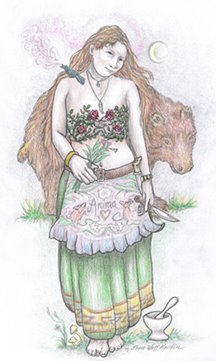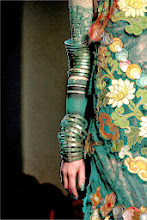 The energetics of primary importance for the practicing herbalist refer to temperature and moistness: hot, cold, dry and moist in varying degrees. If you simply learn to recognize those energies in humans and plants, you will be well on your way to utilizing the enormous potential of herbal energetics.
The energetics of primary importance for the practicing herbalist refer to temperature and moistness: hot, cold, dry and moist in varying degrees. If you simply learn to recognize those energies in humans and plants, you will be well on your way to utilizing the enormous potential of herbal energetics.
Although there is varying ways of understanding the systems in which energetics are organized in the traditional schools of thought, for practical purposes we can simplify it down to a few fairly universal basics. I call my approach Elemental Energetics because I have attempted to simplify my analogies down to the essential elements and because I favor a natural elements based approach to energetics (and because I like to name things). There's nothing here especially profound or new, this is a gentle, common sense synthesis of ancient and modern practices for practicing herbalists wanting a better understanding of energetic herbalism.
First of all, use your innate senses to figure out what the qualities of the individual are. Are they overheated all the time or do they generally feel cold and need extra blankets and clothing to keep warm? Do they have a tendency towards heartburn or constipation? A propensity for scaly rashes or for oily skin and hair? There's plenty of books out there on diagnostics, but old-fashioned observation will tell you a lot. Make a practice of observing the ways in which these different elements manifest, what does a hot, dry person smell like as opposed to a cold, moist person? What does their skin, hair and nails look like?
Now do the same with the plants. How does the plant feel in your mouth and on your skin? Is it slimy when you rub it between your fingers or does it make your tongue dry up in your mouth like strong black tea? Does it warm your belly like a fine curry or leave you cooled down like a fresh garden salad? Of course, there's always your idiosyncratic herbs that don't conform to one end of the spectrum or the other, like Yarrow, which is both warm and cool, but many herbs will fall rather naturally into a category. And even when they don’t you’ll be able to tell, because of they way they feel, you won’t need a medical book to tell you.
Whatever you do, don't give your cold, dry individual a cold, dry detoxifying herb like dandelion or fringe tree, you'll only make them worse. Though current alternative medicine fads dictate detoxing and cleansing just about everything, that approach is only valid when there's an excess that actually needs to be cleared. You'll find that as you correct energetic imbalances, many other symptoms and complaints will naturally subside without even being directly treated.
It's really this simple: if you have a cold, frail individual with cracked, dry heels and lips, then they most likely need a warm, moistening herb. You then find the corresponding herb that best fits with their overall constitution and symptomology. It's all about paying attention to the individual and to the plant. After you've worked within a basic understanding of energetics for a while, it will come to you spontaneously and you won't have to think "hrrmmm, ginger is definitely warm, I wonder if it's dry though? Maybe I should go have some ginger tea. Nope, it's not really dry, maybe neutral or even a little moist..." But then, that's half the fun.
Energetics & Actions
Nearly every herb book on the market contains list upon list of what is generally termed herbal actions. You know what I'm talking about, it's that half page of hyphenated words separated by commas: anti-pyretic, anti-spasmodic, anti-bacterial, refrigerant, demulcent, hypotensive and so on and so forth. These terms are only useful in so far as they actually indicate what the specific plant will do in the body (NOT what they will do in a petri dish or in lab rats that are bred to have cancer). Many of the more modern actions actually refer to biochemical actions that will often be of little use to someone actually working with the whole plant in a practical setting.
The actions I prefer to use are the ones I can observe for myself in practice. As with basic energetics, these can be understood by anyone with a dedication to paying attention. While labratories and allopathic uses of standardized extracts may have their place in our culture, I want most of my medicine to be simple, down to earth and common sense, bringing the power of healing and health back to the hands of the people who need it most.
It is possible to match up energetics with actions in a useful way. For instance, bitter alterative herbs such as dandelion, oregon grape root, mugwort, gentian, goldenseal and vervain are almost invariably cold and dry, while demulcents such as comfrey, mallow, slippery elm and chickweed are usually cool and moist. It can be very useful to chart these energetics/actions out in order to better understand the way a given herb works and how it can be best used in an individual. I'm in the process of doing this for the herbs I most commonly use and will post it when it's done.
Deficiency & Excess
Excess exists when there is too much of something, so that the overall balance of the body is disrupted. Excess can be triggered by too much food, too much alcohol or stimulants or even too much sex. Individuals with excess conditions are often overheated, overfed, aggressive, restless and loud. In other words, stereotypical American. Excess conditions are generally treated with alterative herbs such as burdock, dandelion and barberry, although in cases of cold excess warming digestive herbs such as fennel or may be used.
Deficiency occurs when there's not enough of some necessary force in the body. Dry skin and scanty urine point to a deficiency in fluids. Chronic fatigue, low sex drive and a prolapsed uterus can indicate a deficiency in the vital energy. Deficiencies are usually treated with tonic herbs such as ginseng, peony root and bilberry. Chinese Medicine classifies four primary deficiencies: Yin (fluids), Blood, Chi (vital energy) and Yang (adrenals). Understanding these subtleties is very useful in clinical practice, but unecessary for a basic sense of energetics. I recommend Paul Bergner's The Healing Power of Ginseng & The Tonic Herbs, Matthew Wood's The Practice of Traditional Western Herbalism and Michael Tierra's Planetary Herbology for a better grasp of the subject. Or you can wait until I do a post on it here :)
Recognizing False Heat.
This one's bit tricky at first. Say you have a woman experiencing hot flashes, headaches, irritability and painful urination. She's got excessive heat, right? Well, yes, but not directly. Heat can occur in direct proportion to lack of vital fluids in the body, so check for dryness and other deficiency symptoms before automatically giving her a detoxifying, alterative formula. If she's actually fluid deficient with false heat, you'd want to first provide her with mucilaginous tonic herbs like Marshmallow Root or Black Sesame Seeds.
I'll be adding posts related to Elemental Energetics periodically, including one on basic constitutional types, on Western tonic herbs, and energetics and the organs. I'm also hoping to come up with some graphics that will make illustrating the finer points of energetics a bit simpler.
Thursday, February 8, 2007
Elemental Energetics
Posted by
Oakmoss Changeling
at
1:36 PM
![]()
Labels: Therapeutics and Nutrition
Subscribe to:
Post Comments (Atom)
The Medicine Woman is glad you came...
All writings & posts (c)2007 Kiva Rose
All artwork & photographs (c) 2007 Jesse Wolf Hardin












2 comments:
Great post, Kiva. Thanks for taking on such a daunting task. (You'll notice I haven't gotten around to it on my blog yet.)
Thank you! It is a challenging subject... I really want to present it as a common sense concept that anyone familiar with the plants can integrate into their work... There's endless complexities in energetics of course, but I think there is a unifying root as well.
Now if I can just finish this constitutional model post I'm working on...
Post a Comment